Keywords
|
| ROM based DA,ADDER based DA,MULTIPLEXER based DA, CADENCE 180nm Technology. |
INTRODUCTION
|
| Distributed Arithmetic (DA) has been widely adopted for its computational efficiency in many digital signal processing applications. The most frequently used form of computation in digital signal processing is a sum of products which is dot-product or inner-product generation. DA is generally abit-serial computation operation that forms a product of two vectors in one clock cycle. The typical applications include DCT, DFT (Discrete Fourier Transform), FIR (Finite Impulse Response), and DHT (Discrete Hartley Transform) which can be found in main stream multimedia standards and telecommunication protocols. The advantage of DA is its special non multiplication mechanization which uses adder replacing multiplication and therefore simplifies the hardware implementation. The idea behind the conventional DA, called ROM based, is to replace multiplication operations by pre-computing all possible values and storing these in a ROM. The Adder based DA uses a fixed architecture which can be obtained by distributing fixed variable is used for inner product computation. The DA technique distributes arithmetic operation rather than lumps themas multipliers do. Conventional DA called ROM based DA decomposes the variable input of the inner product into bit level to generate pre-computed data.ROM based DA uses a ROM table to store the pre-computed data, which makesit regular and efficient in silicon area in VLSI implementation. However, when the size of the inner product increases the ROM area increases exponentially and becomes impractically large, even using ROM partition. |
| In contrast to conventional DA, Adder based DA decomposes the other operand of inner product into bit level, distributes the multiplication operation, and shares the common summation terms .The adder based DA exploits the distribution of binary value pattern and may maximize the hardware sharing possibility in the implementation. Although the Adder based DA requires less hardware area and smaller computation cycle time than ROM based DA, both the existing method operates only on one input as fixed but the proposed MUX base DA computes result with both the input as variable as same as MAC. The direct implementation of the filter requires more number of resources, to reduce the number of resources Distributed Arithmetic came into existence which replaces multiplications by additions and siftings. The proposed DA algorithm came into existence which uses multiplexers to remove the usage of ROM memory and complexity in constructing fixed architecture for higher order inputs. The proposed MUX based DA produces inner product computation with both the inputs as variable this has application in point detection, line detection and edge detection in DIP(Digital Image Processing). |
RELATED WORK
|
| A new hardware distributed arithmetic was implemented for high order digital filter. it was termed as reusable distributed arithmetic. It reuses the computational block much like multipliers were used to reduce the hardware complexity [1]. A hybrid adder based DA was implemented to perform discrete cosine transform algorithm based on three processors pure RAM, mixed RAM and CORDIC based RAM[2].Row column decomposition technique was used to compute the two dimensional discrete cosine and inverse cosine transform. Word-level data sharing was computed by using cyclic convolution [3]. |
| Distributed arithmetic (DA) based array for the (1-D) any-length discrete Hartley transform (DHT). A new algorithm was used to formulate the 1-D DHT into cyclic convolution, and realized it in a DA-based array that utilizes identical ROM modules, and eliminate the accumulation loop in the processing elements (PE's)[5]. |
ROM BASED DA
|
| An efficient technique for calculation of sum of products or vector dot product or inner product or multiplies and accumulate(MAC). MAC operation is very common in all Digital Signal Processing Algorithms. Though inner product design using multipliers and accumulator are Fast they associated cost is intolerable .when inner product computation is consider instead of using MAC, Distributed Arithmetic (DA) uses ROM that store the pre computedpartial sum of inner product .The advantages of DA are best exploited in data path circuit designing Area savings from using DA can be up to 80% and seldom less than 50% in digital signal processing hardware designs An old technique that has been revived by the wide spread use of Field Programmable Gate Arrays (FPGAs) for Digital Signal Processing (DSP) DA efficiently implements the MAC using basic building blocks (Look Up Tables) in FPGA. |
| DA is a bit-serial operation that computes the inner product of two vectors without needing to use multiply operations. |
| Figure 1 shows the operation of conventional ROM based DA that decomposes the variable input of the inner product into bit level to generate pre computed data. The ROM based DA uses a ROM table to store the precomputed data, which makes it regular and efficient in silicon area in VLSI implementation. |
| Figure 2 shows the simulation report for ROM based Distributed Arithmetic.The problem with ROM based DA is that its ROM size (2L word) grows exponentially as the order L increases. As the number of inputs and the internal precision becomes large, the ROM based DA suffers from extremely large ROM requirements. To reduce the large memory requirement Adder based DA presents fixed architecture. |
ADDER BASED DA
|
| Adder Based DAA decomposes the fixed coefficients instead of variable input into bit level.The adders with shiftsreplace the multipliers in the original DA algorithm.It is possible to share terms between different bit weights resulting in area saving.The adoption of adders also makes the architecture more hardware efficient. |
| Figure 3 shows the common sharing term which is used in adder based DA. There is one common term sharing scheme: X1 +X3as the common term. Here, only two two-input adder is enough to compute bit weight 21 and 20. |
| Figure 4 shows the adder based DA architecture realizing the bit-serial form of equation |
 |
| The architecture consists of shifters and ripple carry adders. The shifters provide the shift needed and the ripple carry adder(RCA) tree is used to generate final inner product results. |
| Figure 5 shows the simulation report for adder based DA. It is complex to construct fixed architecture in Adder based DA for higher order inputs and also it perform inner product computation only when one input is fixed. This disadvantage is overcome in MUX based DA architecture. |
MULTIPLEXER BASED DA
|
| The advantage of Multiplexer based DA over ROM based DA and Adder based DA is that, it can perform inner product computations for two variable vectors. As per the expression both the multiplier and multiplicand are variables. |
 |
| In MUX based DA the property of multiplexer in implementing basic logic gates is used rather than using parallel AND Gates. Implementation of AND gate using 2:1MUX |
| Basic expression of Multiplexer: Y= a (~s) + b(s) |
| Put a=0 then Y = b(s)Where ?a‘ and?s‘ are vector inputs.Equation defines the AND Gate and can be used in multiplication operation by distributing one variable vector and given it to the select line through the shift register and the other vector to input 2 of MUX.The Figure 6 shows the multiplication of two vector inputs. In most of the multiply accumulate applications in signal processing, one of the multiplicands for each product is a constant. Usually each multiplication uses a different constant. Using most compact multiplier, the scaling accumulator, it is possible to construct a multiple product term parallel multiply-accumulate function in are latively small space if it is willing to accept a serial input.In this case, feed four parallel scaling accumulators with unique serialized data. Each multiplies that data by a possibly unique constant, and the resulting products are summed in an adder tree as shown in Figure 7.If stop to consider that the scaling accumulator multiplier is really just a sum of vectors, then it becomes obvious that we can rearrange the circuit. |
| The adder tree combines the 1 bit partial products before they were accumulated by the scaling accumulator. After rearranging the order in which the 1xN partial products are summed. Instead of individually accumulating each partial product and then summing the results, postpone the accumulate function until after summed all the 1xN partials at a particular bit time. This simple rearrangement of the order of the adds has effectively replaced N multiplies followed by an N input add with a series of N input adds followed by a multiply. This arithmetic manipulation directly eliminates N-1 Adders in an N product term multiply-accumulate function. For larger numbers of product terms, the savings becomes significant. |
| The block diagram of proposed MUX based DA architecture is shown in Figure 8.The proposed architecture takes the advantage of Multiplexer and DA for inner product computation of variable inputs. |
RESULT AND DISCUSSION
|
| The Table 1& Table 2 compare the power, area, and speed of the ROM based DA, Adder based DA, Multiplier based implementation and MUX based DA which is synthesized using ASIC tool - Cadence. |
| Although the existing ROM based DA and Adder based DA achieve good performance in Area, Power, and Speed on comparing with MUX based DA it perform inner product computation with variable inputs. On comparing Multiplier based implementation with MUX based DA, it achieves better performance in Area and Power. |
| The comparison of power among Adder based DA, ROM based DA, MUX based DA and Multiplier implementation (MAC). From the below comparison The MUX DA reduces power upto 81% compared with Multiplier based approach. |
| Figure 9 illustrates the comparison of area and shows that the MUX based DA needs only 40% of area as compared with Multiplier based approach. |
| Figure 10 shows the speed analysis. From this analysis, MUX based DA is a time consuming approach but it is only 7% slower than multiplier based implementation. |
CONCLUSION AND FUTURE WORK
|
| Thus from the above analysis it is clear that, as compared with Multiplier based approach, the multiplexer based DAA has better performance. The MUX based DA achieved good performance in area, power compared. When both the inputs are variables and the proposed architecture performs point, line and edge detection through hardware approach. The MUX based DA has been widely adopted in many digital signals processing application such as DCT, DFT, FIR and DHT. |
| Our future work is to implement Point detection, Line detection, Edge detection in Digital Image processing using MUX based DAA in order to achieve better performance. |
Tables at a glance
|
 |
 |
| Table 1 |
Table 2 |
|
| |
Figures at a glance
|
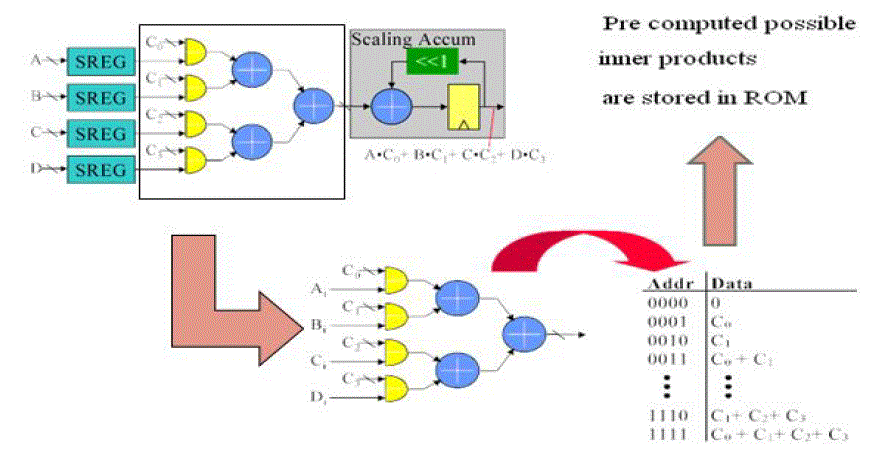 |
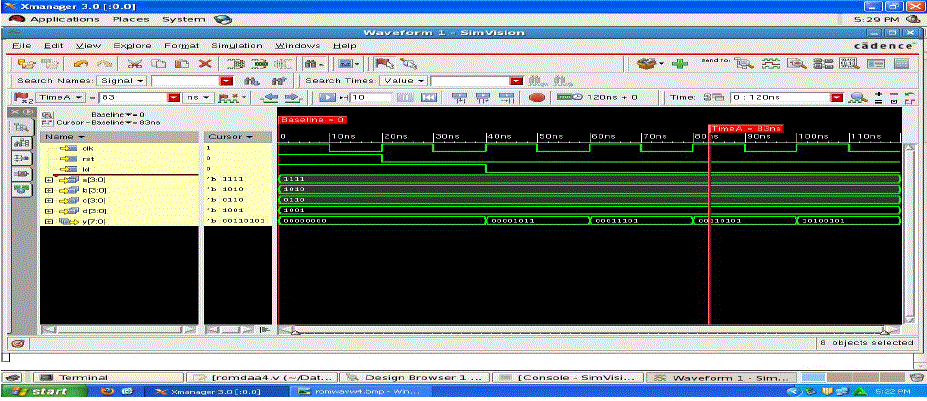 |
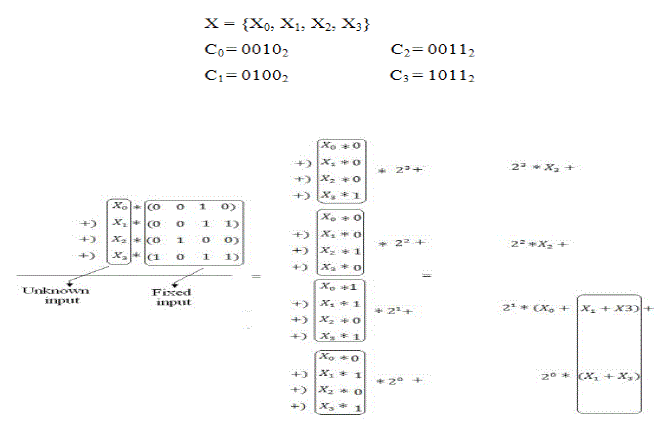 |
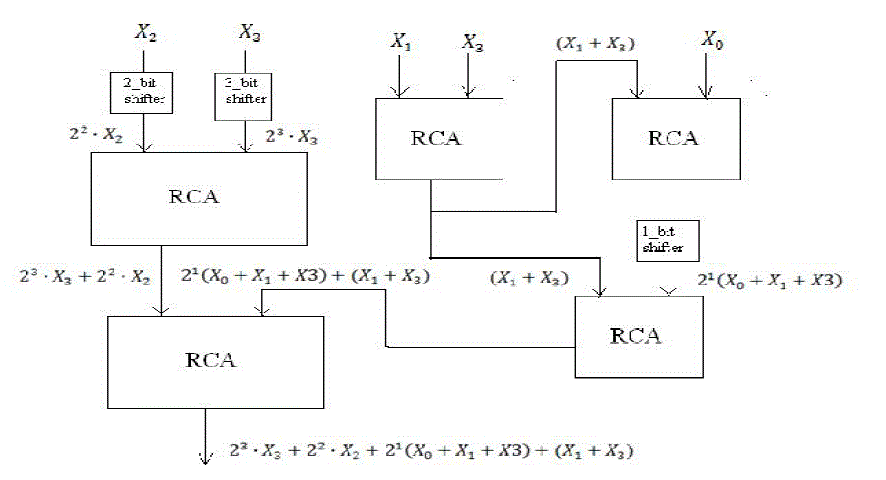 |
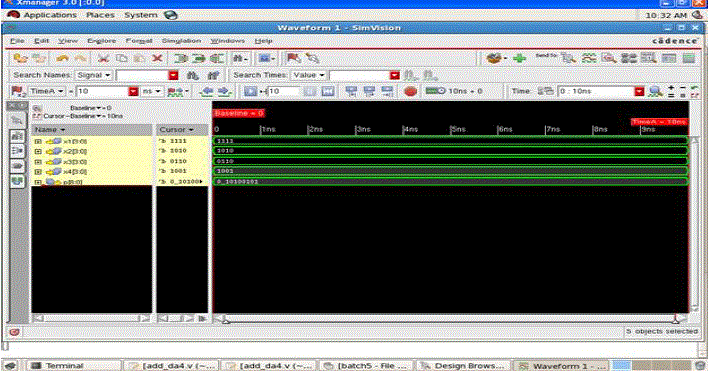 |
| Figure 1 |
Figure 2 |
Figure 3 |
Figure 4 |
Figure 5 |
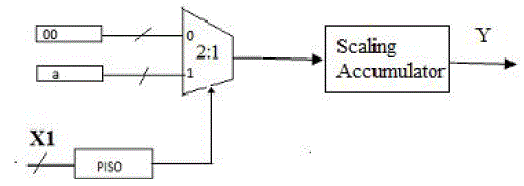 |
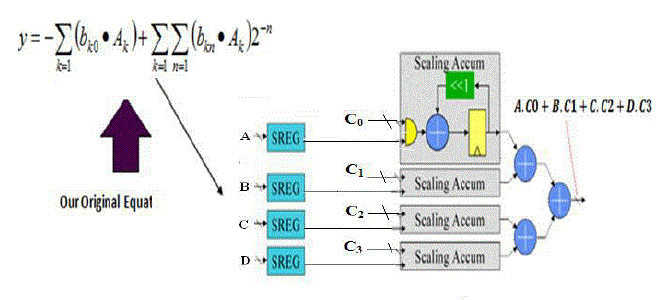 |
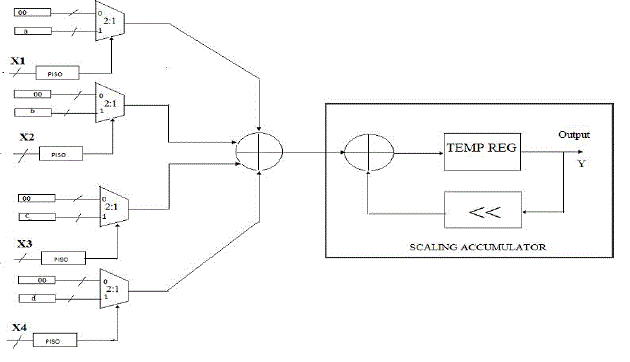 |
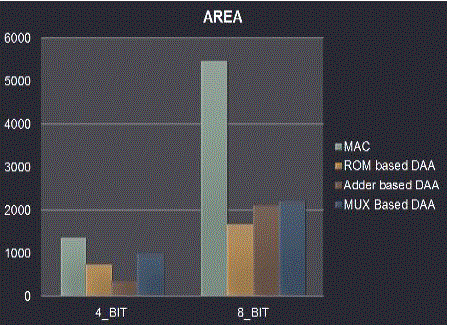 |
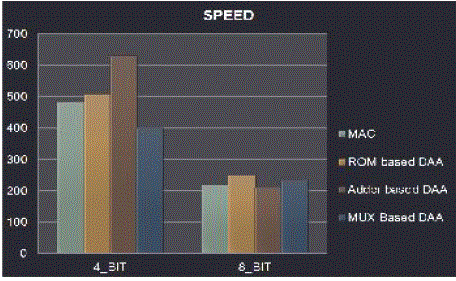 |
| Figure 6 |
Figure 7 |
Figure 8 |
Figure 9 |
Figure 10 |
|
| |
References
|
- Raveenakoppula, S.kMasthan ,“An Efficient Distributed Arithmetic Architecture for High Order Digital Filters”, International Journal ofComputer Trends and Technology, volume 2, Issue 2, 2011.
- Pai, A.K., Benkrid, K., Crookes, D., "Embedded reconfigurable DCT architecturesusing adder-based distributed arithmetic", CAMP, pp. 81-86, 2005.
- Jiun-In Guo, Rei-Chin Ju,Jia-Wei Chen,"An efficient 2-D DCT/IDCT coredesign using cyclic convolution and adder-based realization",Circuits and Systemsfor Video Technology, Volume 14, Issue 4, pp.416 – 428, 2004.
- Marcos R. BoschettiAlexando, "Techniques and Mechanisms forDynamic Reconfiguration in an Image Processor", Integrated Circuits andSystemsDesign, pp.177-182, 2002.
- Jiun-In Guo, "A new DA-based array for one dimensional discrete Hartley transform", ISCAS, vol. 4, pp.662 – 665, 2001.
- S. F. Haiso, W. R. Shiue, and J. M. Tseng, "Design and implementation off a novel linear-array DCT/IDCT processor with complexity oforder log2N", IEE Proc.Visions, Images, and Signal Processing, vol. 147, no.5, pp. 400-408, Oct 2000.
- T.-S.Chang,C.Chen and C.-W. Jen, “New distributed algorithm and its application to IDCT" ,IEE Proc. –Circuits Devices Syst., Vol.146,No.4, August 1999.
|